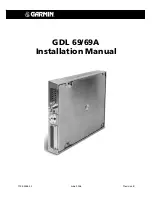
101
190-00607-02 Rev C
Detailed Operation
Radar
MPEL
Boundary
Radome
Center Line of
Aircraft
10.83 ft for 12” ant
Antenna
MPEL Boundary
Antenna tilt Setup at cruise Altitude
The following discussion is a simple method for
setting up the weather radar antenna tilt for most situ-
ations. It is not to be considered an all encompassing
setup that will work in all situations, but this method
does provide good overall parameters for the monitor-
ing of threats.
With the aircraft flying level, adjust the antenna
tilt so ground returns are displayed at a distance that
equals the aircraft’s current altitude (AGL) divided by
1,000. For example, if the aircraft is at 14,000 feet,
adjust the tilt so the front edge of ground returns are
displayed at 14 nautical miles. Note this antenna tilt
angle setting. Now, raise the antenna tilt 6 degrees
above this setting. The bottom of the radar beam is
now angled down 4 degrees from level.
At this point, when flying at altitudes between
2,000 and 30,000 feet AGL, any displayed target
return should scrutinized. If the displayed target
advances on the screen to 5 nautical of the aircraft,
avoid it. This may be either weather or ground returns
that are 2,000 feet or less below the aircraft. Raising
the antenna tilt 4 degrees can help separate ground
returns from weather returns in relatively flat terrain.
This will place the bottom of the radar beam level with
the ground. Return the antenna tilt to the previous
setting after a few sweeps.
NOTE:
At aircraft altitudes under 5,000 feet AGL,
false returns are possible due to reflections from
side-lobe beams.
If the aircraft is above 29,000 feet, be cautious
of any target return that gets to 30 nautical miles or
closer. This is likely a thunderstorm that has a top high
enough that the aircraft cannot fly over it safely.
If the aircraft altitude is 15,000 feet or lower, set
the displayed range to 60 miles. Closely monitor any-
thing that enters the display.
Also, after setting up the antenna tilt angle in
this manner, ground returns can be monitored for
possible threats. A ratio of approximately 100 to 1
exists between vertical distance from the aircraft and
horizontal distance. Therefore, at this antenna tilt
setting, a target return at 1 NM is approximately 400
feet below the aircraft; at 10 NM, 4,000 feet below; at
50 NM, 20,000 feet, etc. In other words, at this tilt set-
ting, a ground return (such as a mountain peak) being
displayed at 10 NM would have a
maximum
clearance
of 4,000 feet. If that ground target return moves to 5
NM,
maximum
clearance will be 2,000 feet.
This setup will provide a good starting point for
practical use of the GWX 68 Weather Radar System.
There are many other factors to consider in order to
become proficient at using weather radar in all situa-
tions.
Содержание GMX 200
Страница 1: ...GMX 200TM Pilot s Guide Reference ...
Страница 26: ...14 190 00607 02 Rev C Getting Started Function Summary ...
Страница 146: ...134 190 00607 02 Rev C Index This page intentionally left blank ...
Страница 147: ......





































